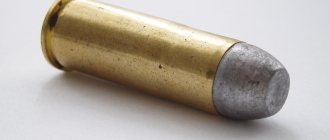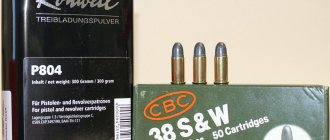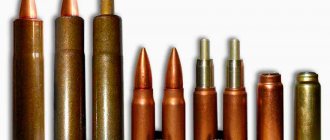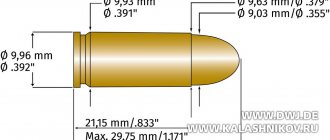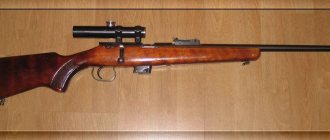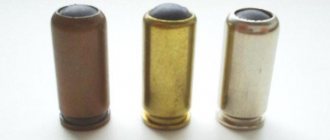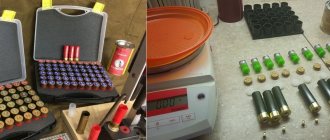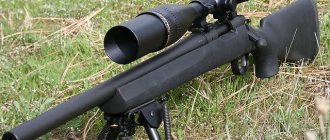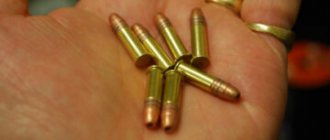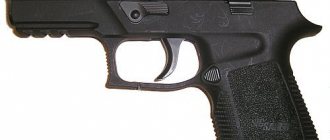Encyclopedia of weapons
Cartridge 10×22 / .40 Smith & Wesson, 1990, USA
Tactical and technical characteristics .40 S&W (10×22) Caliber, mm - .40 S&W (10×22) Bullet leading part diameter, mm - 10.2 Cartridge length, mm - 28.83 Case length, mm - 21.6 Case shoulder diameter, mm - 10.74 Case base diameter, mm - 10.77 Case flange diameter, mm - 10.77 Case flange thickness, mm - 1.40 Bullet weight, g - 8.7-13 Initial bullet velocity, m/s — 305-360 Bullet energy, J — 533–790 Maximum pressure, MPa — 240 (35,000 psi)
| Basic ballistic characteristics of .40 S&W bullets | ||
| Bullet weight, type, g | Bullet speed, m/s | Muzzle energy of a bullet, J |
| 135 gr (8.7 g) Federal Premium JHP Reduced Recoil | 360 | 575 |
| 155 gr (10.0 g) Guardian Gold JHP | 367 | 680 |
| 165 gr (10.7 g) Remington Golden Saber | 350 | 658 |
| 180 gr (12 g) Magtech FMJ-FP | 320 | 598 |
| 200 gr (13 g) Doubletap FMJ-FP | 320 | 660 |
| The test was carried out with a barrel length of 4 inches. | ||
The development of the cartridge was started by the famous American arms company Smith & Wesson in 1986 by order of the FBI. The customer set the task of creating ammunition that would provide fairly accurate shooting, but would have more power than 9 mm cartridges. In addition, customers considered it important to ensure that the bullet also produced a powerful stopping effect upon impact. At the same time, it was necessary to combine this with the minimum possible return.
The 0.40 inch (10.2 mm) caliber was proposed for this purpose by one of the FBI employees who owned his own (not service) weapon chambered for 10 mm Auto. This employee suggested reducing the power of the 10 mm Auto cartridge, which was too high and had an extremely negative effect on shooting accuracy.
Experts from Smith & Wesson believed that the 10 mm Auto cartridge, developed a little earlier, was too long, and it also gave the bullet too high an initial velocity, while excessive recoil seriously hampered targeted shooting. At the same time, the FBI used 10 mm FBI load cartridges with reduced powder charges, the power of which could be realized in cartridges with smaller case volumes.
The designers followed this path, leaving the caliber 10.2 mm, as in 10 mm Auto, but reducing the length of the sleeve from 25.2 to 21.6 mm. The bullets in the new cartridge were the same as in the 10 mm Auto, although the FBI found it possible to use lighter bullets as standard, reducing the desired bullet weight from 13.6 to 12.24 grams and the muzzle velocity from 366 to 300 meters per second.
The result is a completely new ammunition that successfully combines the increased stopping effect (due to the rather large affected area) at the level of the .45 ACP cartridge, but with less recoil and the penetrating effect at the level of the 9x19 Parabellum cartridge. When developing the .40 Smith & Wesson, the goal was to create a cartridge with ballistics identical to the 10 mm FBI load cartridge.
Taking these factors into account, the arms company Smith & Wesson, together with another major American ammunition manufacturer, Winchester - Olin, created a shorter pistol cartridge of 10x22 mm caliber in 1989-1990. The new cartridge was soon designated .40 S&W (Smith & Wesson), which was excellent for use in double-stack magazines.
The .40 S&W cartridge went into production in 1990. Almost simultaneously, Smith & Wesson began serial production of pistols for this ammunition. The new cartridge has firmly taken its place between the two “kings” - the European 9 mm Parabellum and the American .45 ACP.
Over the next 5 years, the .40 Smith & Wesson cartridge became the “holy grail” of American law enforcement. It has been adopted by the FBI, the US Secret Service and many police departments throughout the United States. Almost all world arms manufacturers (including Russian ones) began to produce pistols chambered for this cartridge.
The most widely used .40 Smith & Wesson cartridges produce muzzle velocities from 305 to 360 meters per second and energy from 560 to 790 Joules with a bullet weighing 12.24 grams.
The ammunition uses the usual type of bullet - blunt-headed, semi-jacketed. The cartridge case is cylindrical in shape with a non-protruding flange.
The main advantages of the .40 S&W are its relatively small size, allowing the creation of compact weapon models, and efficiency comparable to the 10 mm Auto in a lightweight version of the equipment at a slightly lower operating pressure.
The .40 Smith & Wesson cartridge very quickly gained wide popularity both in the American police and in the FBI, since it provided greater efficiency compared to the standard 9x19 Para cartridge with a smaller size and recoil of the weapon during shooting than the 10 mm cartridges common in the United States Auto and .45 ACP.
The FBI equips its officers with .40 caliber Glock pistols and 11.22 gr HydraShok bullets. at an initial speed of about 300 m/s. The US Drug Enforcement Agency equips its employees with pistols from various manufacturers (Glock, Heckler-Koch USP, SIG-Sauer P229) and cartridges with a Remington Golden Saber bullet weighing also 11.22 grams and an initial speed of about 350 m/s.
Smith & Wesson quite rightly counted on a large market for weapons chambered for cartridges that met FBI requirements. Although skeptics dubbed the new .40 S&W cartridge “weak,” its ballistic tests clearly showed that it is not only an excellent police ammunition, but also an excellent sporting cartridge - at least for the US civilian weapons market.
This was also facilitated by the fact that in 1995, American legislators banned the use in the United States of civilian and sporting large-caliber weapons with a magazine capacity of more than 10 rounds. The ban affected many self-loading pistols designed to use 9x19 Parabellum cartridges, although the large magazine capacity of such models was almost their main advantage.
Now this advantage has disappeared, and sports shooters, having quickly lost interest in the 9x19 Parabellum cartridge, switched to weapons of .45 ACP and .40 S&W caliber. Therefore, the new cartridge soon found a large number of supporters in the United States, and many companies began producing the corresponding pistols and cartridges.
Soon after the introduction of the .40 Smith & Wesson cartridge and weapons of this caliber, the 10 mm Auto gradually faded into the background, and was practically forced out of the service weapon market, remaining mainly as a sporting weapon - in light equipment options, and as a hunting ammunition.
Smith & Wesson was a major success in this field. New Smith & Wesson pistols chambered for .40 S&W, due to more acceptable recoil, smaller dimensions than other similar models, as well as good fighting qualities, on the contrary, gained popularity and began to be produced in significant quantities.
In addition, based on the .40 S&W cartridge, the Swiss concern SIG created a new cartridge - .357 SIG (9x22 mm), which is also gaining wide recognition.
‹ .505 Gibbs cartridge Up 10×25 Auto cartridge ›
- 37933 views
Cartridge dimensions
The .40 S&W has a 1.25 ml (19.3 grain H2O) case capacity.
Total rifling twist rate for this cartridge is 406 millimeters (16.0 in), 6 grooves, bevel = 9.91; mm, groove ∅ = 10.17 mm, chamfer width = 3.05 mm and primer type small gun.[4] According to official CIP recommendations, the .40 S&W case can withstand piezo pressures up to 225 megapascals (32,600 psi). In countries where CIP is regulated, each gun/cartridge combination must be proven at 130% of that maximum CIP pressure in order to be certified for sale to consumers. In SAAM, the pressure limit for the .40 S&W is set at 241.32 megapascals (35,001 psi) piezo pressure.[9]
Outage reports
The Beretta 96 .40 S&W feed ramp
has been noted in a number of case failures, especially in older Glock pistols due to the relatively large unsupported case head area in these barrels at high operating pressures.[21][22] The rear ramp on Glock .40 S&W pistols is larger than on other Glocks, which leaves the rear lower portion of the case unsupported, and it is in this unsupported area that cases fail. Most, but not all, failures occurred with reloaded or reconditioned ammunition.[23] Cartridges loaded at SAAMI pressure or higher, or slightly oversized cases that fire slightly out of battery are often considered to be the cause of these failures,[23] which are commonly referred to as "kaBooms" or "kB!" for brevity.[23] While these housing failures do not often result in injury to the person holding the pistol, the release of high pressure gas tends to force the magazine out of the magazine in a spectacular manner and usually destroys the pistol. In some cases, the barrel will also fail, tearing off the top of the chamber.
Recommendations
- "MidwayUSA - Shooting, Hunting and Outdoor Supplies Store." MidwayUSA
. Archived from the original April 22, 2022. Retrieved May 9, 2018. - ^ a b
"CIP solutions, texts and tables - free download of the current version of CIP on CD (ZIP and RAR formats)." Archived from the original on September 29, 2008. Retrieved October 17, 2008. - "Taffin Tests: .40 S&W." Archived from the original on September 27, 2007. Retrieved September 25, 2007.
- ^ a b
Hornady's Handbook of Ammo Reloading, Fourth Edition (1991), pp. 593–595. - "Smith & Wesson .40: This cartridge came at the right time and in the right place." thefreelibrary.com
. Retrieved March 4, 2022. - ^ a b
Spear's Reloading Guide #12 (1994), pp. 534–542. - ^ a b
Nosler Reloading Guide Number Four (1996), pp. 529–534. - Street Stoppers, E. Marshall and E. Sanov, Paladin (1996) p. 118
- "Saami Pressure". Archived from the original on October 14, 2007. Retrieved November 29, 2007.
- "New Life for an Old Cat (Stoeger Model 8000 Cougar)." Archived from the original on September 27, 2007. Retrieved September 25, 2007.
- ballistics101.com. "Smith & Wesson .40 Caliber Ballistics Card - Ballistics 101." Ballistics101.com
. Archived from the original October 5, 2022. Retrieved May 9, 2018. - ballistics101.com. "9mm Ballistics Map - Ballistics 101." Ballistics101.com
. Archived from the original April 7, 2022. Retrieved May 9, 2018. - ballistics101.com. "Ballistics Card 45 ACP - Ballistics 101." ballistics101.com
. Archived from the original October 5, 2022. Retrieved May 9, 2018. - Ammunition and Hollow Point Pistols: The Possibility of Large Temporary Cavities, Fernando Spencer Netto, Dylan Pannell, Homer K. Tien, Injury Extra (2008) 39, 50–52.
- Street Stoppers, E. Marshall and E. Sanov, Paladin (1996), pp. 25–58.
- ^ a b
Marshall and Sanow, Street Stoppers, Paladin (1996), pp. 115–131. - Chuck (February 25, 2010). “Ten-X Cowboy Ammo 38-40 WCF 180 Grain Lead Round Nose Flat Point Box.” midwayusa.com. Archived from the original April 7, 2012. Retrieved March 27, 2013.
- "SAAMI Pressure Characteristics". Archived from the original on September 28, 2007. Retrieved September 25, 2007.
- Braking Power, E. Marshall and E. Sanov, Paladin (2001), pp. 49–58.
- Nosler Reloading Manual Number Four (1996), pp. 529–534.
- ".40 S&W Case Failures in Glocks." Archived from the original on September 27, 2007. Retrieved September 25, 2007.
- Towsley, Bryce (24 June 2009). "Removing the Glock 40 S&W Bulge." Gun Digest
. Archived from the original on July 23, 2010. Retrieved August 8, 2010. - ^ a b c
“Glock kB!
FAQ". Weapons zone
. Weapons zone. Archived from the original on June 10, 2011. Retrieved July 3, 2011.
